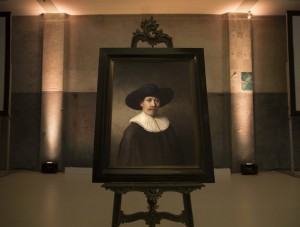By: Sooraz Bylipudi, Sridhar Sriram and Sachit Jain
Section 9

“The Next Rembrandt” is a digitally-created interpretation of Rembrandt by inputting 346 of the painter’s works into a deep-learning algorithm. This algorithm, in turn, extracted subject matter, geometric patterns, and facial proportions from the works to create a new portrait of Rembrandt. After going through the algorithm, the portrait was then laid down on canvas by a 3D printer to recreate the depth of Rembrandt’s brushstrokes and illusion of texture. Truly, this work personifies the collision between old and new— art and science; thus questioning our ideas of what art really is.
For our exploration into Dutch heritage and its influence in the contemporary world, our group chose a different type of painting – The Next Rembrandt. As the name implies, the painting has a correlation to Rembrandt van Rijn, the famed Dutch painter and etcher. In fact, some could make the case that Rembrandt himself created The Next Rembrandt. However, the actual credit for this painting goes to Bas Korsten, Ben Haanstra, data analytics and teams from Microsoft, the Maurithsuis in The Hague, Technical University Delft, and the Rembrandt House Museum in Amsterdamm. Together, all of these entities created The Next Rembrandt – a portrait created by software that interpreted the geometry and composition of 346 of the artist’s works and an additional height map that mimicked the artist’s brushstrokes.
While The Next Rembrandt has yet to placed in a certain location, we are certain that the painting will find a home in Amsterdam, where it will be unveiled. The obvious reason for this location is presumably because of the intimate proximity of Amsterdam to Rembrandt’s heart. While The Next Rembrandt is presumed to reside in the Netherlands, the connections to America are found in the collaboration embraced by the project members. Microsoft, which appears to be the single tech corporation spearheading the group of data scientists and academics, is a renowned American company – and the sole American company in this case. However, what is interesting is the spirit of teamwork that was adopted by the entirety of the group members in order to accomplish this project – a spirit that echoes the partnership shared between early citizens and the Dutch in colonial America.
The Next Rembrandt stood out from the other artifacts that our group surveyed because of the precedence and standard that this project is setting. To blend the worlds of art and algorithm to mimic the work of one of the greatest artists in history opens up the potential of such technology to be applied for restoration projects and greater artistic feats. Furthermore, this “artifact” gives a voice to the data analytics, engineers, and academics alike of today by providing a novel way to look at the past – by virtually creating the past. In doing so, the students of today gain a hands-on example of topics studied for centuries. In a world that is constantly advancing in technology and programs, there is something humbling and academically tantalizing of using our advances to create a reflective way to look at and examine our past.
Bibliography:
http://www.telegraph.co.uk/news/2016/04/05/is-this-the-ultimate-rembrandt-portrait/
http://www.livescience.com/54364-computer-creates-new-rembrandt-painting.html
https://www.nextrembrandt.com/
https://espresso.economist.com/c05ac6c12d237b0c49173d25d0f704cc
